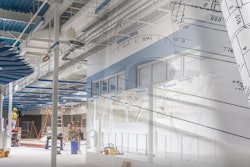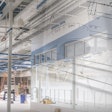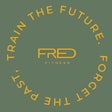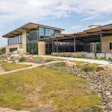The 'solution' is to understand design trends, have a clear plan in place when deciding to build or renovate, and to ensure that the facility meets the needs of your members.
"Fitness continues to be increasingly looked upon as an essential part of healthy living, to the extent that every living environment is making such activities available, convenient and affordable," says Donald DeMars, chairman and CEO of Donald DeMars International, West Hills, Calif., an architecture and interior design firm specializing in the fitness industry. In fact, the number of fitness facilities in the U.S. continues to outpace the number of members, with new building and renovations occurring in all markets. The reason for this, believes Rudy Fabiano, president of Fabiano Designs, an architecture and design firm for the industry based in Montclair, N.J., is an understanding that "this is a fairly stable industry with a lot of growth potential, and a good return on investment."
New building and renovations
According to DeMars, 64 percent of the projects his company has been involved with in the past 18 months are new construction, which includes brand new building and site work, as well as conversions of existing buildings that were designed for another use. Another 13 percent are major renovations (more extensive reworking of existing, older facilities), and 23 percent are light remodels. Who is doing the most new construction and renovations? Hervey Lavoie, president of Ohlson Lavoie Collaborative, a Denver, Colo.-based architecture firm focusing on fitness, recreation, sports and aquatics facilities, says that, from his firm's perspective, "commercial clubs are doing the most renovating, [while] non-profits and institutionals are doing the most new construction." Fabiano says that there is an aggressive push by commercial facilities with recreational and family based programming to get to the market. And, he says, "facilities like community centers, YMCAs, JCCs or large private sector clubs are devoting large resources to club expansions and development."Design considerations
Who is doing what? Lavoie says that his firm is seeing many fitness centers that were built in the '80s taking on major renovation projects. Fabiano adds that many facilities are moving from destination locations (those tucked away where land and rent are cheaper) to retail locations, which have high visibility and are easy to get to, but that usually cost more to build. "Certainly, we have seen some national players use this strategy very effectively to generate large membership numbers," he says. And, the industry is developing a new breed of facility. "These are the integrated lifestyle enhancement facilities," says Fabiano. "Facilities that incorporate wellness, fitness, spas, and family and kids' activities, but also have medical service components built in."As far as interior design goes, Lavoie says that facilities are addressing ADA-accessibility issues, and they are adding group exercise studios, expanding facilities for kids, improving social areas, expanding fitness areas, reducing or simplifying food and beverage operations, and adding aquatics indoors and out. Fabiano says that interior design spaces are becoming more refined and highly specific. "The design is responding to the specific activities occurring within," he says. The experience created in fitness centers is starting to mirror the experiences you might expect in nice hotels, restaurants and spas.
Design trends
Many trends are driving new construction and renovations. "Competition is the biggest influencer," says Lavoie. "Many established club facilities are trying to protect their market share from big box category killers and non-profits."Fabiano says his firm's research has shown that interaction in the fitness center is a driving trend in design - it's all about making members feel comfortable and at home. Areas that can promote and accommodate member-to-member interactions (social nodes) "work well in establishing contacts and friendships in a club," he says. "Waiting areas outside of studios, near the workout floor and along travel paths work well for this." Also important, he says, is developing member-to-staff interaction and member-to-facility relationships. For instance, how easy is it to maneuver in the facility? How well does the design articulate your members' needs? How does the facility fit into your members' lifestyles?
Creating family friendly facilities is another important trend. "In the non-profit sectors, I think there is a deep understanding of the benefits of fitness and wellness activities to the individual and the family as a socially based destination," Fabiano says. "They promote that time spent at the YMCA is family time well-spent on ... activities that will promote a lifetime of healthy habits."
And, let's not forget the green movement. Many facilities being built and renovated are making environmentally friendly decisions. "There are real economic long-term savings in hard dollars in energy costs," says Fabiano. "Also, savings in reduction of the dependency on fossil energy, as well as the emotional, physical and marketing benefits of a 'green' building cannot be ignored." A recent survey by ReliableRemodeler.com shows that the "go green" philosophy is hitting the mainstream, with 60 percent of homeowners surveyed stating that green building practices are more important to them now than they were five years ago. "A commitment to healthy, energy-efficient, environmentally sensitive buildings is a reinforcement of our dedication to the health and well-being of our patrons," says Fabiano.
A master plan
A good design is only as good as its plan. Lavoie says that when designing a facility, planners need to think beyond current needs and be a master planner. "Strive for perfection in planning before tackling style, color and beauty," he says. "The keys to a great plan are fit, function and flow." Fabiano agrees: "How to maximize value in a project and still deliver a market icon takes tremendous planning and coordination." Designing a facility is the fun part, says Fabiano. "The real challenge is in managing the whole process, from understanding the appropriate programming, spending client's money wisely on appropriate materials and concepts, and coordinating the many diverse groups and ideas during the process that really brings profitability and success to the project," he says.Lavoie says that many things need to be considered, such as creative code compliance strategies, cost control, staging and phasing for cost-efficiency, and staying open for business during construction. "It is so often true that renovations are not intended to satisfy current members, but to attract new joiners," says Lavoie. "This takes the right spin in order not to alienate your current members." And, he says, be prepared for the unexpected.




































